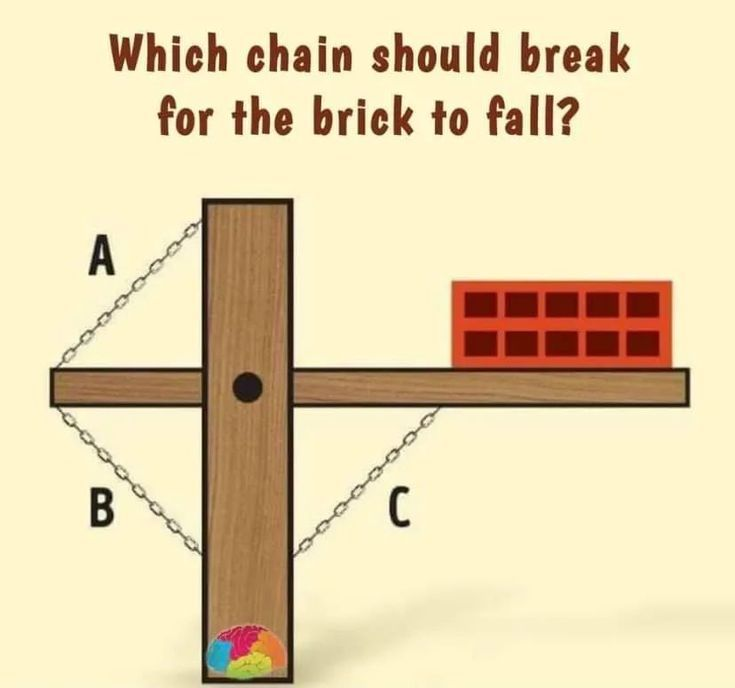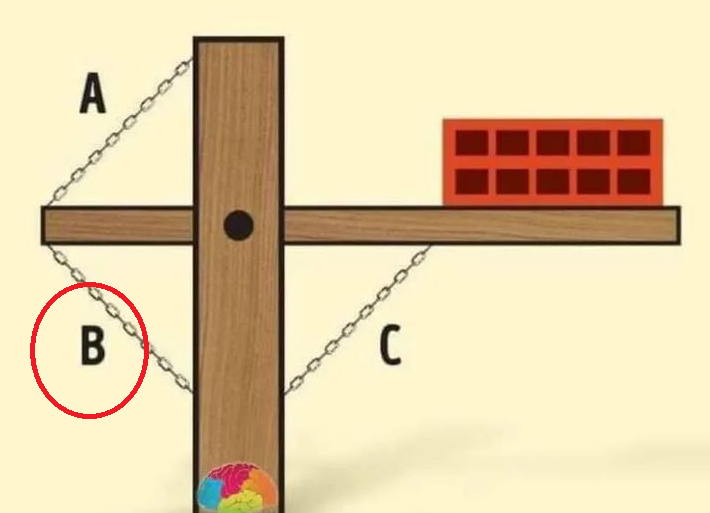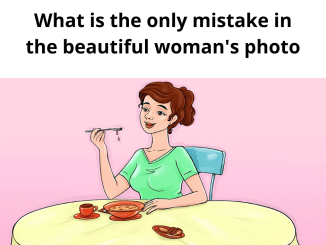Puzzles like the one you’re about to see aren’t just for fun—they’re brain-boosting, coffee-spilling, mind-blowing riddles that challenge how we perceive mechanics and logic. Today’s challenge looks simple on the surface: a brick is resting on a horizontal wooden plank supported by three chains—A, B, and C. But the question is… which chain should break for the brick to fall?
Think you’ve got the answer? Great! But before you scroll down, take a good look, test your deduction skills, and let’s walk through it together.
The Puzzle Setup

The image presents a horizontal wooden beam supported on the left and right by three chains:
- Chain A connects from the upper left of the vertical support to the left side of the beam.
- Chain B goes from the bottom of the vertical post to the underside of the left side of the beam.
- Chain C stretches from the underside of the right side of the beam (where the brick is) back to the vertical support.
The brick sits firmly on the right-hand side of the beam. But here’s the real question: If one of these chains breaks, which one will cause the brick to fall to the ground?
Why This Riddle Trips People Up
At first glance, many folks focus on the chain closest to the brick—Chain C. After all, it’s directly underneath the part of the beam that supports the weight. Others guess Chain A because it connects to the top and may appear more essential. But here’s where it gets sneaky: not all support is created equal.
The visual illusion here tricks your eyes into assuming that the chain directly beneath the brick is the most critical. But gravity, torque, and balance tell a deeper story.
Step-by-Step Analysis of the Puzzle
Let’s break it down from a physics and mechanical reasoning standpoint.
Video : which chain must be broken for the load to fall 🧩
Step 1: Understand the Role of Each Chain
- Chain A (top left) is under tension. It pulls upward, holding the left side of the beam in place.
- Chain B (bottom left) is under compression support. It helps balance the torque created by the weight of the brick on the right.
- Chain C (bottom right) helps resist the downward force created by the brick. But it’s not as essential as you may think.
Step 2: Consider Torque and Rotation
When the beam supports a heavy object (in this case, the brick on the right), it wants to rotate clockwise due to that weight. To prevent this, something on the left side must resist that motion—this is where Chain B plays a critical role.
If Chain B breaks, the left side of the beam loses its resistance to the downward force on the right. The beam will then rotate clockwise, causing the right end to fall—and so does the brick!
Step 3: Visualize What Happens If Each Chain Breaks
- If Chain A breaks: The top-left support is gone, but Chain B still holds the left end from underneath. The system may tilt slightly but remain stable.
- If Chain C breaks: Surprisingly, not much changes. The beam may dip slightly, but Chains A and B keep it balanced.
- If Chain B breaks: Boom. The whole system collapses clockwise, and the brick crashes down.
Answer: Chain B Must Break for the Brick to Fall
Did you get it right? If yes, give yourself a pat on the back. If not—no worries! That’s the magic of puzzles like this: they sharpen our critical thinking and show us that logic sometimes hides behind the obvious.

Common Mistakes and Why We Make Them
Mistake 1: Picking Chain C Too Quickly
This is the most common response. Our brains associate “what’s directly under the object” with “what’s holding it.” It’s natural to assume the bottom chain directly beneath the brick is the one doing all the work. But in physics, that’s not always the case.
Mistake 2: Ignoring the Role of Torque
Torque—aka rotational force—is often overlooked in puzzles like this. In real-world structures, beams rotate or pivot based on where the force is applied. This detail is easy to miss unless you’re actively thinking about balance and resistance.
Mistake 3: Assuming Equal Roles for All Chains
Each chain serves a different purpose based on its placement. Just because it’s attached doesn’t mean it’s equally important.
What This Teaches Us About Problem Solving
Riddles like these are more than games—they’re mental gymnastics. They remind us to:
- Look beyond the surface
- Consider all forces at play
- Understand that sometimes the solution hides in the least obvious detail
Video : GUESS the FOOD by EMOJI 🤔 Emoji Quiz – Easy Medium Hard
This kind of thinking applies in real life too, from engineering problems to decision-making in business. The ability to analyze systems and predict outcomes is an essential life skill.
Let’s Hear From You!
So now it’s your turn. Did you get it right? Did you fall into the Chain C trap? Either way, we’d love to hear your thought process.
Drop a comment below with your answer before you read the explanation (be honest!). And if you enjoyed this challenge, share it with a friend and see how they do!
Final Thoughts: Keep Challenging Your Brain
In a world full of mindless scrolling, taking a few minutes to solve puzzles like these is a great way to exercise your brain and stay sharp. They test not only what you know but how you think—and that’s where real intelligence shines.
So go on, seek out more brain teasers, challenge your friends, and most importantly, keep thinking critically. Because every time you pause to ask why, you’re training your mind to see beyond the obvious—and that’s a superpower worth developing.


